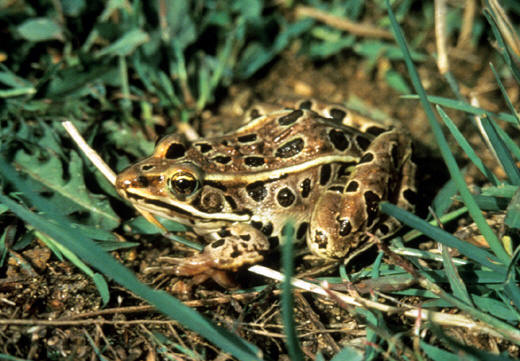Adaptation
Rana pipiens has adapted in multiple ways to avoid being captured by predators or to capture their own prey.
Feet and Legs The northern leopard frog has developed powerful legs in which they have become amazing swimmers and jumpers. They can leap five to six feet in a zigzagging pattern to avoid being eaten. The legs have been elongated which allows for the frog to push harder on the ground allowing the frog to jump higher and further On the topic of their extremities, the northern leopard frog has webbed digits, which allow them to be such proficient and fast swimmers to avoid and capture their own prey.
 Skin
The northern leopard frog has also adapted its skin, so that it
creates a camouflage to not be seen by other organisms. Thos frog
has a brownish-green color skin with clack spots that have a yellow
ring around the edges. The brownish-green color allows the frog to
blend in with the surrounding vegetative environment to stay hidden
from its predators and not be seen by its prey.
Click here to see more pictures of the northern leopard frog.
Skin
The northern leopard frog has also adapted its skin, so that it
creates a camouflage to not be seen by other organisms. Thos frog
has a brownish-green color skin with clack spots that have a yellow
ring around the edges. The brownish-green color allows the frog to
blend in with the surrounding vegetative environment to stay hidden
from its predators and not be seen by its prey.
Click here to see more pictures of the northern leopard frog.
 Respiration
and Circulation The skin of Rana pipiens is
permeable to oxygen, water, and carbon dioxide. In addition to
this, the frog has blood vessels close to the surface of the skin,
which allows the frog to respire while underwater
since the oxygen can be directly transmitted through the skin into
the blood stream. When the frog is on land, it uses its lungs to
breathe. This frog takes in its oxygen through the nostrils and
exhales through the nostrils as well. The northern leopard frog
must respire through its nostrils since, unlike humans, it does not
have a diaphragm or ribs to expand the chest cavity and allow for
oxygen intake. Instead the frog must breath through its nostrils
which causes the throat to bulge out and compresses the floor of the
mouth which then forces air into the frogs lungs.
Click here to learn more about the three-chambered heart.
Click here to compare the three-chambered heart to that of the
two and four chambered hearts.
Respiration
and Circulation The skin of Rana pipiens is
permeable to oxygen, water, and carbon dioxide. In addition to
this, the frog has blood vessels close to the surface of the skin,
which allows the frog to respire while underwater
since the oxygen can be directly transmitted through the skin into
the blood stream. When the frog is on land, it uses its lungs to
breathe. This frog takes in its oxygen through the nostrils and
exhales through the nostrils as well. The northern leopard frog
must respire through its nostrils since, unlike humans, it does not
have a diaphragm or ribs to expand the chest cavity and allow for
oxygen intake. Instead the frog must breath through its nostrils
which causes the throat to bulge out and compresses the floor of the
mouth which then forces air into the frogs lungs.
Click here to learn more about the three-chambered heart.
Click here to compare the three-chambered heart to that of the
two and four chambered hearts.
Like most tetrapods, excluding the birds, mammals, and crocodilians, the northern leopard frog has a three-chambered heart. This allows for oxygenated blood to reach tissues in the body and brings in de-oxygenated to become re-oxygenated by the lungs for a continuous cycle.
Digestion The northern leopard frog has a unique adaption for capturing its prey, a sticky tongue. The sticky tongue allows the frog to target and capture flies and other insects.
The nervous system of
Rana pipiens consists of
a brain, spinal cord, and nerves.
This nervous system allows the frog to interpret and react to
its environment and its surroundings.
In addition to this the frog has tympanic membranes that are
directly exposed, unlike most animals having external ears covering
the eardrums.
Go Home, or continue to learn more about the Nutrition of the Northern Leopard Frog.
Back to http://www.multipleorganisms.net


